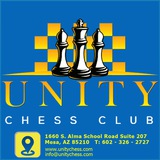If White plays prosaically and blockades the a-pawn with 32.Ra4, then after 32...Nf6 33.Nc5 e5!, the solidity of White’s central construction is broken, and he does not win the a5-pawn.
The point of White’s idea is revealed after 32...Rxa5 33.Qxa8+ Rxa8 34.Rxa8+ Kh7 35.Rb7 – the Nd7 is lost, as on 35...Qd6 there follows a pin from the other side — 36.Rd8.
33.Nb3 Rxa1 34.Nxa1 Ra2 35.Nc2 exd4 36.Qc8+ Kh7 37.Qc4 Ra8 38.Qd3+ Kg8 39.Nxd4
With the presence of knights, White’s winning chances are very considerable, and in a long battle, he succeeded in realising his extra pawn.
After 28...Rxd6 29.Nxd6 Qc6 30.Nxc8 Qxc8 31.Rd8+, Black loses all his pieces.
Unity Chess Club
Evgeny Bareev 2707 Peter Leko 2713 Wijk aan Zee 2002 White to move
The knight is an agile piece, and the X-ray on the long diagonal allows a tactical idea that was seen in the game:
Black must lose the exchange, after which the realisation is a simple matter of technique.
29...Bxb2 30.Ne7+ Kg7 31.Nxc8 Qf5 32.Nd6 Qf3+ 33.Kg1 Be5 34.Qc2 h5 35.h4 Qg4 36.Kg2
Repeating moves to save time before the time-control, a typical device that is useful to employ sometimes.
